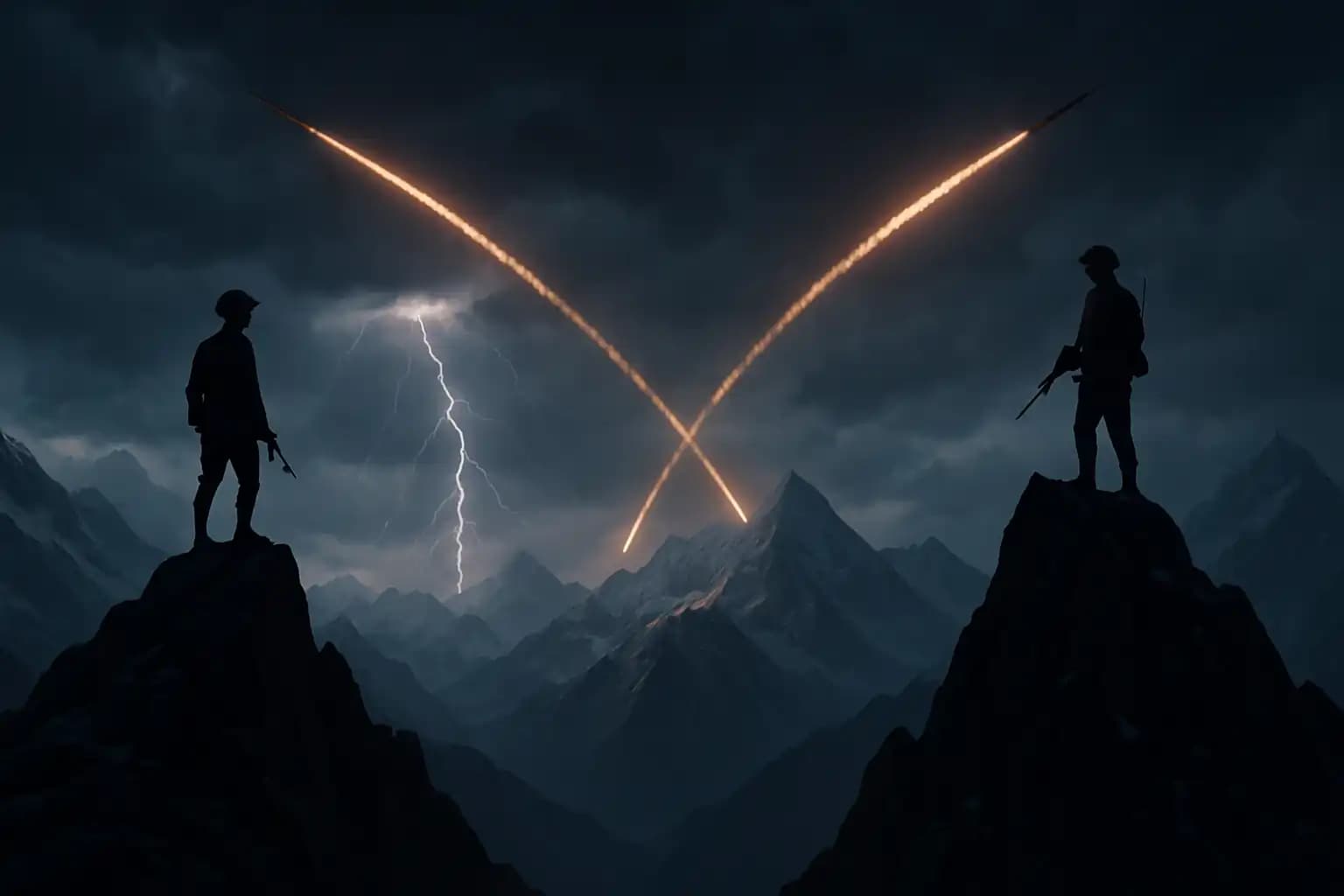Grainy footage shows armed militants attacking a tourist convoy in Kashmir, leaving the asphalt slick with panic and blood. Within minutes, the video floods social feeds from Rawalpindi to Washington, making the hashtag #KashmirFlashbang trend faster than a crypto pump. Forty-eight hours later, Indian missile batteries mobilize up Himalayan switchbacks. Pakistan scrambles fighter jets, and Chinese armour columns conduct “routine winter training” across the Line of Actual Control. In silence above 14,000 feet, you can almost hear history skid on ice.
South Asia has danced on the edge before, but the choreography has never been this complex or digital. With Islamabad reeling and New Delhi furious, Beijing senses leverage. A miscalculation could turn a local tragedy into the twenty-first century’s most perilous three-front war.
Pakistan’s Kashmir Flashbang Sets the Stage
On a humid July morning, gunmen with Chinese-made QBZ-191 rifles attacked a bus of domestic tourists near Pahalgam. Indian intelligence traced the plot to the banned outfit Lashkar-e-Taiba within hours, but New Delhi’s anger focused on Pakistan’s Inter-Services Intelligence directorate. A leaked briefing published by NBC News claimed “credible intel” of a follow-up strike inside Indian territory, turning television studios into nightly war rooms.
The rhetoric escalated faster than atmospheric CO2. Prime-ministerial surrogates invoked a “zero-hour doctrine.” Islamabad’s foreign minister warned that “any kinetic move will be met, missile for missile.” Civilian airlines diverted around Lahore. Analysts scrolled the Global Conflict Tracker, noting the region’s risk meter inching toward scarlet.
Underground forums buzzed too. A post on seconds-before-midnight-07112024 described freight trains hauling mysterious cargo eastward through Balochistan—“possible MIRV casings,” the user alleged. Pakistani officials dismissed it as conspiracy fodder, but jitters spread to currency markets, tanking the rupee three percent in a single session.
Beijing’s Calculus Along the Line of Actual Control
The Himalayas stand as a wall of snow and rock, also serving as a spreadsheet of leverage. Every skirmish along the LAC allows Beijing to probe Indian resolve and refine logistical loops across the Tibetan Plateau. Last winter, PLA engineers paved a new spur road, bringing armour trucks within twenty-two kilometres of India’s Pangong Tso lake positions—an achievement dissected in think-tank memos and on sites like dragon-endgame-06212024.
Chinese diplomats frame their moves as de-escalatory. Yet satellite images reveal a harsher story: hardened shelters, expanded helipads, and ECM arrays that can jam Indian radars from deep inside Aksai Chin. “It’s the classic ‘peace through superior positioning’ playbook,” says Colonel (ret.) Anika Verma, a former Indian signals officer at the Observer Research Foundation. She points to recent construction of ‘Xiaokang’ dual-use villages—civilian façades masking garrison infrastructure—first outlined in the CSIS ChinaPower report.
Beijing also plays the Pakistan card with deliberate flourish. When state media amplified Islamabad’s grievances after the Pahalgam massacre, Chinese diplomats proclaimed “all-weather friendship,” echoing language chronicled in pacific-escalation-the-brewing-storm-of-us-china-relations-11252023. For New Delhi, that felt uncomfortably close to a green light.
Delhi’s Twin-Front Nightmare and Military Math
India’s strategists have rehearsed the two-and-a-half-front war scenario for decades: Pakistan in the west, China in the north, and domestic insurgencies gnawing at the seams. The current crisis puts that simulation on real-world timelines. “We can concentrate heavy force on one border for thirty days,” admits a serving brigadier. “But two major fronts will overstretch manoeuvre brigades and high-altitude logistics.”
Armoured regiments redeploying from Rajasthan toward Ladakh must rumble through the Siliguri corridor—India’s thin ‘Chicken Neck’ that Chinese missiles could bottle within minutes. A landslide or drone strike could orphan entire divisions in the mountains. Op-eds in subcontinental-standoff-india-pakistan-edge-toward-nuclear-night-06132024 urge Delhi to accelerate the Strategic Partnership Roadmap with Washington, as U.S. carrier groups loiter in the Bay of Bengal.
A newly declassified U.S. intelligence assessment underscores how quickly a conventional duel can become a nuclear alert. The document models a “10-day punitive campaign” leading to Pakistani battlefield nukes and Chinese “limited intervention” to secure Gwadar port. That hypothetical now feels less like fiction and more like tomorrow’s meeting agenda at South Block.
Nuclear Signaling and the Subcontinental Red Lines
The subcontinent’s nuclear architecture is an uneasy tripod. India pledges “no first strike,” Pakistan rejects this outright, while China claims restraint while fielding MIRV-capable DF-41s. During the 2019 Balakot crisis, Delhi and Islamabad activated secure hotlines only after warplanes crossed each other’s radar nets. Analysts fear the current tempo erodes that fragile muscle memory.
A chilling primer on doomsday automation—Pakistan’s rumored “Nasr sprint nuclear artillery”—surfaced on dead-hand-rising-06222024. Critics dismissed the idea of an AI-driven launch circuit as “Bond-villain tech,” but a senior U.S. STRATCOM officer claims the concept is neither impossible nor unaffordable. “You can strap a neural-net decision aid to a legacy command line for the price of a Hollywood blockbuster,” he warns. “In crisis, speed trumps elegance.”
Moscow once deployed its own semi-automated system—code-named Perimetr—to guarantee retaliation after decapitation. South Asia’s geography compresses warning times further: a BrahMos ER launched from the Thar Desert could reach Karachi in under four minutes. At that velocity, algorithms may soon choose between peace and ash.
Can Diplomacy Outrun the Algorithms of War?
Track-two envoys met quietly in Muscat last week, exchanging draft communiqués that promise hostage releases and hotline upgrades. However, diplomats admit that public opinion—superheated by 24/7 feeds—often knocks their carefully worded statements off the front page before the ink dries. A think-tank fellow quoted in dragon-endgame-06212024 calls it “the TikTokification of deterrence.”
One glimmer of optimism comes from energy math: full-scale war would vaporize $150 billion in annual trade and spook investors from Mumbai to Shenzhen. Chinese exporters need India’s consumer market almost as much as Indian pharma needs Chinese precursors. That mutual dependency could stall trigger fingers, unless leaders decide that sovereignty trumps GDP—a familiar refrain in every nationalist rally.
Yet optimism cannot substitute for architecture. Arms-control veterans propose a tri-lateral verification regime, with AI-monitored geofencing along border artillery zones and blockchain-logged troop withdrawals. It sounds futuristic, but recall that open-source mappers on social platforms already do half that work with hobbyist satellites.
Backchannel chatter hints at a bigger carrot: a region-wide climate-resilience fund co-chaired by India and China, underwritten by Gulf petrodollars. If Pakistani flood reconstruction dovetails with Ladakh’s solar-microgrid push, the same corridors that today move troops could tomorrow ferry lithium batteries.
None of that can erase the graves in Pahalgam or the artillery smoke above the Karakoram. Yet history teaches that even rivals on the brink sometimes step back. They do so not because they trust one another, but because they fear the alternative documented daily on sites like Unexplained.
The next seventy-two hours will test whether wiser heads can throttle the momentum before the region reaches its point of no return. For now, satellites stare, radars hum, and the wind races across high passes where three nuclear powers watch each other through gunsights—wondering who blinks first.




